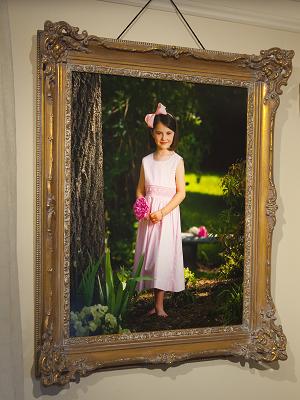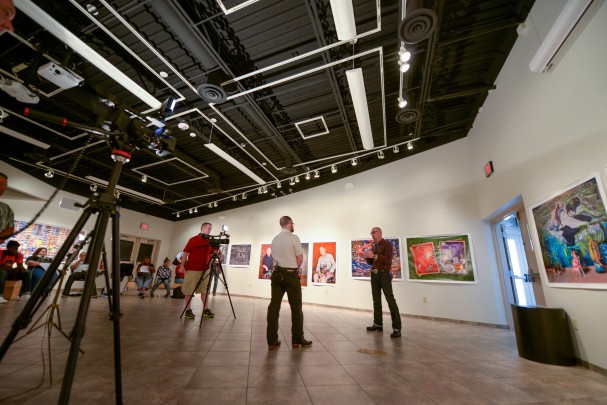
We recently caught up with Steven Katzman, a decorated photographer whose work could be best described as documentarian. However, there’s no one word that can describe his work, which, while straightforward, requires thought, introspection and interpretation from the viewer of his photography.
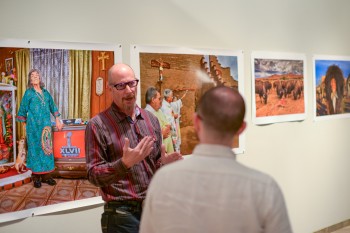 Katzman’s most recent project, This Miserable Kingdom, is no different. The project documents the surviving members of the Pojoaque Pueblo people of Pojoaque, New Mexico. Katzman’s photography captures the essence of the Pojoaque Pueblo in 21st Century America while evoking their ancient past through their near extinction as a people.
Katzman’s most recent project, This Miserable Kingdom, is no different. The project documents the surviving members of the Pojoaque Pueblo people of Pojoaque, New Mexico. Katzman’s photography captures the essence of the Pojoaque Pueblo in 21st Century America while evoking their ancient past through their near extinction as a people.
In the short excerpt in the video embedded below from our conversation with Katzman about This Miserable Kingdom and the exhibition held at the State College of Florida in Bradenton, Jan. 31 through April 2, he discusses the importance of his relationship with LexJet during his move from analog to digital printing. Later, we’ll air the full story behind this exhibition – his thought process, the history of the Pojoaque Pueblo and how he captured the striking images – as well as his ongoing work on this project.
 It was during this transition from analog to digital that Katzman was running into issues with inkjet printing, specifically metamerism on glossy inkjet papers. Metamerism is no longer an issue thanks to better printer and ink technology, but it was one of Katzman’s hurdles early on.
It was during this transition from analog to digital that Katzman was running into issues with inkjet printing, specifically metamerism on glossy inkjet papers. Metamerism is no longer an issue thanks to better printer and ink technology, but it was one of Katzman’s hurdles early on.
“Metamerism wasn’t a problem with matte papers, so I was always using various fine art papers, but I didn’t get the same Dmax as luster and glossy substrates,” explains Katzman. “Being born and raised in the analog environment – wet processing doing my own black-and-white printing – my primary print medium was KODAK ELITE Fine-Art Paper, a fiber-based paper that had the most silver in the industry.”
Then, as Katzman notes in the video, he found LexJet and began working with Alex Ried, who would use Katzman as a sounding board for new inkjet papers that sought to emulate what Katzman was missing from the darkroom.
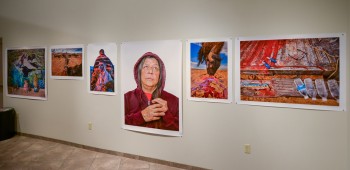 “Time goes by and Alex came to me with some paper he wanted me to try, which would eventually become known to the market as Sunset Fibre Elite. It was nice; it resembled the paper I had used in the past. Now, almost everything I print is on Sunset Fibre Elite,” says Katzman. “The reason I use the paper is not only for the qualities it has inherently to digital output, but how closely related it is to the finest silver halide papers once widely used in the industry.”
“Time goes by and Alex came to me with some paper he wanted me to try, which would eventually become known to the market as Sunset Fibre Elite. It was nice; it resembled the paper I had used in the past. Now, almost everything I print is on Sunset Fibre Elite,” says Katzman. “The reason I use the paper is not only for the qualities it has inherently to digital output, but how closely related it is to the finest silver halide papers once widely used in the industry.”
Ultimately, Katzman looks for a paper that “doesn’t get in the way of the image,” as he puts it. Metamerism was definitely getting in the way, and he needed a medium that would bring out the tones of images – both subtle and stark – that are one of the hallmarks of his photography.
 “Photographers will use different types of surfaces, from canvas to fine art papers, but that’s not my vision and not how I want my images to be seen. I want an edge in detail. Whenever you use a semi-gloss paper that resembles the air-dried of an analog paper you’re getting the maximum resolution off those pixels,” explains Katzman. “To use a material that would diffuse that because of some atmospheric impression you want to add upon the scene goes against how I was brought up in terms of my own influences: Ansel Adams, Group f/64, and particularly Edward Weston. That’s why I’m using this paper. The way I present the digital image is the same as the way I presented it 20 years ago, and as far as that translation, it’s seamless. I have to output it, and I have to output it on Sunset Fibre Elite.”
“Photographers will use different types of surfaces, from canvas to fine art papers, but that’s not my vision and not how I want my images to be seen. I want an edge in detail. Whenever you use a semi-gloss paper that resembles the air-dried of an analog paper you’re getting the maximum resolution off those pixels,” explains Katzman. “To use a material that would diffuse that because of some atmospheric impression you want to add upon the scene goes against how I was brought up in terms of my own influences: Ansel Adams, Group f/64, and particularly Edward Weston. That’s why I’m using this paper. The way I present the digital image is the same as the way I presented it 20 years ago, and as far as that translation, it’s seamless. I have to output it, and I have to output it on Sunset Fibre Elite.”
Though fairly dogmatic about his use of Sunset Fibre Elite to adequately portray the reality of his photography, Katzman is adamant that he’s not making a blanket statement about the right medium to use for photography in general.
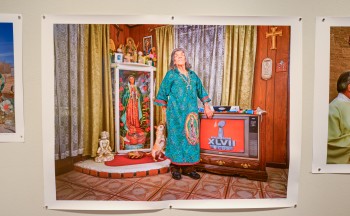 “Not one material supports all images. I’ve used Sunset Photo Metallic on traditional images and it provided a different interpretation of what I was trying to capture. On these different elements you have subject matter, the technical aspect and the material. If the material interferes with the first two, then as a photographer, you’ve failed to bring all three together and minimized the impact of what you’re trying to say. I don’t want that articulation to be diminished by the texture of the material. I’m not saying that’s right or wrong, but for this photographer, I don’t want it to get in the way of the reality I’m capturing,” explains Katzman.
“Not one material supports all images. I’ve used Sunset Photo Metallic on traditional images and it provided a different interpretation of what I was trying to capture. On these different elements you have subject matter, the technical aspect and the material. If the material interferes with the first two, then as a photographer, you’ve failed to bring all three together and minimized the impact of what you’re trying to say. I don’t want that articulation to be diminished by the texture of the material. I’m not saying that’s right or wrong, but for this photographer, I don’t want it to get in the way of the reality I’m capturing,” explains Katzman.
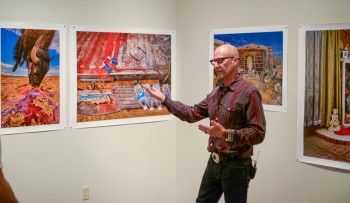 For This Miserable Kingdom Katzman was looking for that “wow factor,” with print sizes of the two dozen or so images featured in the exhibit at the State College of Florida ranging from 24″ x 36″ to 44″ x 80″. The range of print sizes maximized the range of his 44″-wide Epson Stylus Pro 9900 inkjet printer.
For This Miserable Kingdom Katzman was looking for that “wow factor,” with print sizes of the two dozen or so images featured in the exhibit at the State College of Florida ranging from 24″ x 36″ to 44″ x 80″. The range of print sizes maximized the range of his 44″-wide Epson Stylus Pro 9900 inkjet printer.
“All of the sudden when they see that image, they question what it is and how it was made: of course it’s a photograph, but maybe it’s not, but it can’t be a painting, because the colors are so vibrant and their point of reference is a smart phone capture, drug store prints or the family album. I can’t tell you how many times I had to tell them it was a photograph,” says Katzman. “With the PhaseOne IQ180 digital back I used and the Sunset Fibre Elite at those sizes I’m gaining so much information about what I’m documenting it adds another layer of reality to those who are going to look at that particular image. That’s the layer of reality where people are confused. That hyper sense of reality is very important to me, and at the same time it’s something the viewer is unaccustomed to.”

